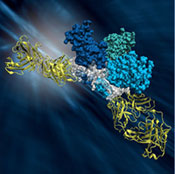

Wednesday - December 10, 2008
SLAC Today is
available online at:
http://today.slac.stanford.edu
In this issue:
Revealing a Structural Weakness of the Deadly Ebolavirus
People Today: Life's One Eclipse after Another
Annual Holiday Party "Season of Cheer"
Ladder Safety Tips
 |
 |
|
Wednesday - December 10, 2008 |
Revealing a Structural Weakness of the Deadly Ebolavirus The structure of Ebolavirus GP.
Scientists are one step closer to conquering the deadly Ebolavirus, thanks to research conducted at the Stanford Synchrotron Radiation Lightsource structural biology Beamlines 9-2 and 11-1 and Advanced Light Source Beamline 5.02 by a team of researchers led by Erica Ollmann Saphire from the Scripps Research Institute. The results were published in the July 10 edition of the journal Nature. Using macromolecular crystallography techniques, the team solved the structure of a protein on the Ebolavirus's surface, called glycoprotein GP, in complex with a rare antibody identified in a human survivor. The glycoprotein–antibody complex proved especially challenging to crystallize and subsequently, to yield well-diffracting crystals. The team grew about 50,000 crystal samples and screened 800 of the largest, using in part the highly-automated robotics hardware and software at the SSRL beamlines, before finding a sample that would diffract to 3.4 Angstroms. The Ebolavirus causes a severe hemorrhagic fever with 50-90% lethality. There are no vaccines or treatments yet available. In order for Ebolavirus to infect a host, it must first recruit one of the host's own enzymes to uncover a portion of the glycoprotein required for infection. This work explains how GP reveals its host binding sites, drives fusion of the viral and host membranes, and disguises itself from surveillance of the immune system. The structure also explains why antibodies that neutralize the virus are so rare, identifies the very few locations on the Ebolavirus where an antibody might attach itself, and thus provides structural templates that can be used to develop vaccines and antibodies against the virus. To learn more and to view a 3-D animation of the virus, see the full scientific highlight. |
||
|
|
||

Life's One Eclipse after Another
On the wall outside Cherrill Spencer's office, a scientific poster describes a prototype for a new type of accelerator magnet; a card thanks her for donating her long hair to make a wig for an ailing girl; and a scribbled note points to a spot on a map southeast of Novosibirsk, Russia. It reads, "This is where Cherrill will be on 1st August, 2008 at ~17h Siberian time." Above it is a photo she shot, from that out-of-the-way spot, of a total solar eclipse.
It's one of dozens Spencer has taken since 1983, when her first eclipse, on the island of Java in Indonesia, gave her a new focus for planning vacations. Eclipse-chasing has taken her to Hawaii, Zambia, Australia and Libya. She saw the sun wink out from a ship on the Caribbean and waited in an English drizzle for the clouds to part—which they finally did, for 10 seconds. "I like to travel," she says, "and it was an excuse to go to all these places. I choose my total eclipses based on where they are, and whether I'd like to visit that place, and whether I've been there before." Read more in Symmetry magazine... See more eclipse photos from Spencer's trip to Novosibirsk. |
Annual Holiday Party "Season of Cheer"
All SLAC employees are invited to jump into the holiday season with a scrumptious buffet luncheon next Wednesday, December 17. This year’s festivities will begin at 11:00 a.m. and end at 1:30 p.m. Feast on turkey with all the trimmings (vegetarian items available, too). Swing to the music, talk to Santa, watch the movie (to be announced) or try your luck in the holiday raffle. A great event not to be missed! See the party Web page for more information. Ladder Safety TipsJust as you check any other tool or instrument before starting work, so should you check your ladder. It's easy to take ladders for granted at SLAC; they are everywhere, from the office to the back of a work truck. Used incorrectly, a ladder can become your enemy. More than 500,000 people across the U.S. are injured every year using ladders incorrectly. Use these tips to keep yourself safe while using a ladder: • Use the correct ladder for the work: single, extension or step. • Choose the correct height and duty rating. • Never use a ladder if it is damaged, broken or bent. • Read the manufacturer's recommendations for the ladder. • In setting up a ladder, make sure its feet are on firm, even ground. • Keep your body between the rails: use the "belt buckle" rule. • Never stand on the ladder top (cap) or the rung just below it. • Do not stand at or above the third rung of a straight or extension ladder. • Do not "jog" the ladder over; get off the ladder and move it to the new work area. Read more... |
Events
Access (see all)
Announcements
|
| | ||
|
|
||
 <%
Response.AddHeader "Last-modified", getArticleDate()
'Response.AddHeader "Last-modified","Mon, 01 Sep 1997 01:03:33 GMT"
'Monday, December 06, 2010
%>
<%
Response.AddHeader "Last-modified", getArticleDate()
'Response.AddHeader "Last-modified","Mon, 01 Sep 1997 01:03:33 GMT"
'Monday, December 06, 2010
%>View online at http://today.slac.stanford.edu/. |
||